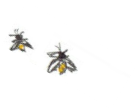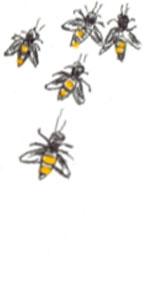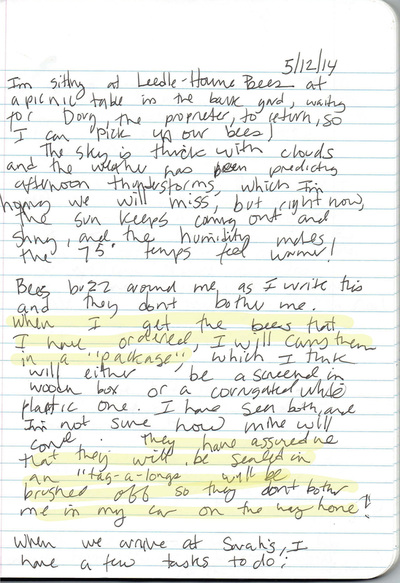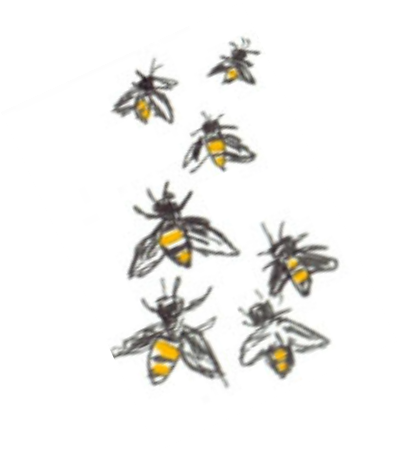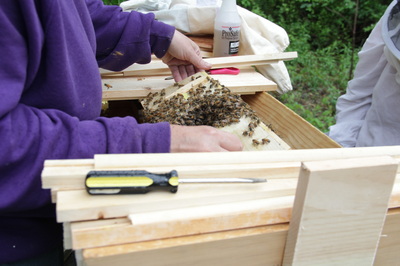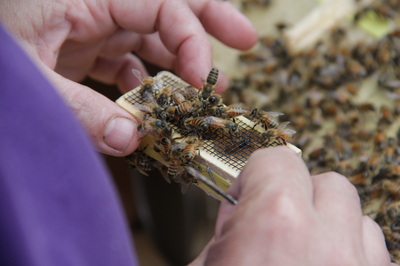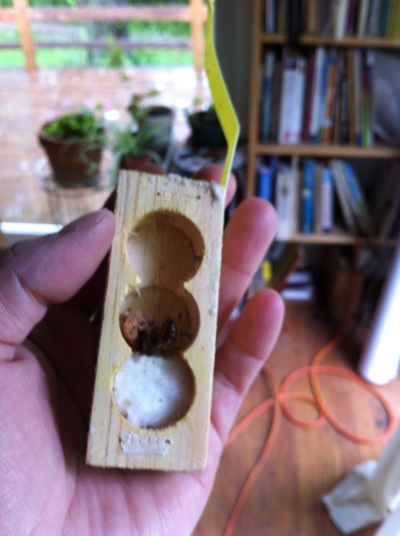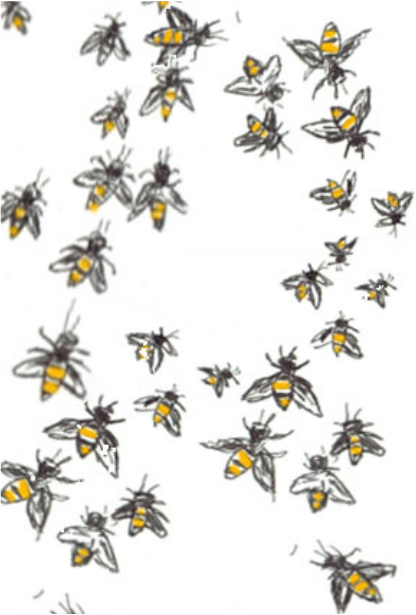
It is a cold day for mid May,
and it’s been raining since early this morning. The shop is warm, and Doug has my new queen tucked under a cloth napkin when I arrive. He picks up the plastic cage and shows her to me. He says she is a Carniolan, an Eastern European variety, instead of the Italian ones I have. Small and dark, her long abdomen easily distinguishes her from her attendant, who is buzzing around with her. I tuck the cage in my hoodie pocket, and Doug walks me out. “Don’t want to get wet?" he says, making fun of the flowery umbrella I’ve left outside the door. I was here just two days ago. It was sunny, and I was sitting at the picnic table watching bees buzz around while I waited for Doug to meet me so I could pick up a package of bees for my first hive. Matt and I had just spent a whole day building a top-bar hive, and I was excited—and a little nervous—to finally, to get the bees. I wondered what a “package” would look like. It turned out to be a wooden, screened in box containing about 10,000 bees—including another queen, separated in a small cage. Doug brushed off the outside to make sure there weren’t any “hangers on” before putting the bread-box sized package in the back of my hatchback. I knew that they were well contained, but the constant hum still raise my heartbeat on the half-hour drive back to Mud Farm. |
Matt and I moved the hive down to the field and Alexa took pictures while we waited for Angie, an experienced beekeeper, to come and
help me open the package. It was somewhat anti-climatic that first day. I got all geared up in my new veil and gloves, and we just ended up
setting the package inside the hive. Angie pried out the feeder can, which had given them sugar on the road, and we closed up the hive and left
them like that, thinking they’d come out on their own. The next day, I came back, intending to take out the queen cage, attach it the hive, and remove
a piece of cork, so that the bees could eat the sugar pellet covering the entrance and set her free. The idea is to hold the queen captive while the bees
get used to their new home, so they don’t just fly away. The bees hadn’t come out of the package, though; they were still clustered around their queen,
and getting her out looked a little harder than I’d expected.
help me open the package. It was somewhat anti-climatic that first day. I got all geared up in my new veil and gloves, and we just ended up
setting the package inside the hive. Angie pried out the feeder can, which had given them sugar on the road, and we closed up the hive and left
them like that, thinking they’d come out on their own. The next day, I came back, intending to take out the queen cage, attach it the hive, and remove
a piece of cork, so that the bees could eat the sugar pellet covering the entrance and set her free. The idea is to hold the queen captive while the bees
get used to their new home, so they don’t just fly away. The bees hadn’t come out of the package, though; they were still clustered around their queen,
and getting her out looked a little harder than I’d expected.
Photos by Alexa Nutilie

Angie came back that afternoon to help, and this time she opened the hive in nothing but a T-shirt, despite serious allergies that she has developed from years of tending bees. I was all suited up, and I watched her in awe as she stuck her bare hand into the writhing mass and carefully extracted the queen cage. We could see a couple of attendants, who seemed agitated, in the cage. Something was wrong. I looked closer, wondering if the other small
body I saw could be the queen. “I think she’s dead,” I said. Angie looked closer and confirmed my suspicion. “What should we do?”
Angie said, “Call Doug,” and I pulled out my phone and got him on speaker. “It’s OK,” he said, “that happens sometimes.
Just come by the shop tomorrow, and I’ll give you a new one.
We opened up the cage to free the attendants and left the queen in the hive with the bees, hoping they’d stay put till I could bring them a new queen and get them used to her scent. We closed up the hive and went inside. “The queen is dead!” I said to Joseph, in the house.
“That’s a Smiths song,” he replied. “No,” I said, “She’s really dead.”
body I saw could be the queen. “I think she’s dead,” I said. Angie looked closer and confirmed my suspicion. “What should we do?”
Angie said, “Call Doug,” and I pulled out my phone and got him on speaker. “It’s OK,” he said, “that happens sometimes.
Just come by the shop tomorrow, and I’ll give you a new one.
We opened up the cage to free the attendants and left the queen in the hive with the bees, hoping they’d stay put till I could bring them a new queen and get them used to her scent. We closed up the hive and went inside. “The queen is dead!” I said to Joseph, in the house.
“That’s a Smiths song,” he replied. “No,” I said, “She’s really dead.”

So I’m driving back to Mud Farm, now, and I still have the Carniolan in my pocket. The rain has subsided, but it’s threatening to come back
any time. Alexa has offered to meet me and bring her patio umbrella to work under if we need to. We’ve got to get this queen in the hive.
I’m suited up, and Alexa is wearing long pants and has her rain coat zipped as high as it goes, just leaving a small opening for her face. She keeps
a bit of a distance, but is close enough to take pictures and hold up the umbrella while I work. I struggle to get the smoker lit, and give up on it, eventually, figuring I’ll just squirt them with sugar water.
The first thing I do is to pull out the old queen. Bees are still clinging to her, and I have to brush them off. I set aside the wooden cell with the dead bee, and I pull the package of bees out of the hive. Most of them still haven’t exited the box. I take the new queen—in a plastic cage this time—and I stick a bent-open paperclip through it, careful not to poke the queen or her worker. Next, I hang the paperclip from one of the top bars of the beehive. The bees have been in the package long enough that they have made an oval-shaped piece of comb the size of my palm. I am amazed by its whiteness and intricacy. It is perfect. I carefully pull it out of the package and press its edge gently to fix it to one of the top bars. These are far too delicate of movements to do with my clumsy gloves, so I am working bare handed. I am surprised by the wind I can feel from the bees’ wings. At some point, I get stung, and I feel like it is a rite of passage.
I really am a beekeeper now. I pull the stinger out and put mud on it, just like we used to do when I was a kid.
any time. Alexa has offered to meet me and bring her patio umbrella to work under if we need to. We’ve got to get this queen in the hive.
I’m suited up, and Alexa is wearing long pants and has her rain coat zipped as high as it goes, just leaving a small opening for her face. She keeps
a bit of a distance, but is close enough to take pictures and hold up the umbrella while I work. I struggle to get the smoker lit, and give up on it, eventually, figuring I’ll just squirt them with sugar water.
The first thing I do is to pull out the old queen. Bees are still clinging to her, and I have to brush them off. I set aside the wooden cell with the dead bee, and I pull the package of bees out of the hive. Most of them still haven’t exited the box. I take the new queen—in a plastic cage this time—and I stick a bent-open paperclip through it, careful not to poke the queen or her worker. Next, I hang the paperclip from one of the top bars of the beehive. The bees have been in the package long enough that they have made an oval-shaped piece of comb the size of my palm. I am amazed by its whiteness and intricacy. It is perfect. I carefully pull it out of the package and press its edge gently to fix it to one of the top bars. These are far too delicate of movements to do with my clumsy gloves, so I am working bare handed. I am surprised by the wind I can feel from the bees’ wings. At some point, I get stung, and I feel like it is a rite of passage.
I really am a beekeeper now. I pull the stinger out and put mud on it, just like we used to do when I was a kid.
Photos by Alexa Nutile

After I breathe a little bit, I put my veil back on and double, triple tuck
my shirt into my belt. A lot of the bees have come out of the package by now, and I’m ready to close them up and let them settle in. We have to feed them sugar water until they get established, and I’ve mixed up a jar that I put in now. I place the remains of the package on the ground in front of the entrance, hoping the bees will find their way into the hive on their own time. Sure enough, in a couple of hours, the box is empty. Click here for more about this project . . |

